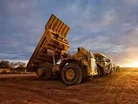The 5 biggest things in mining you missed this week

1. Going digital: why innovation is critical for the mining industry

Just like any struggling industry, innovation continues to be a critical element to the mining sector’s recovery and future success. Here’s why:
A recent IDC Energy Insights research survey of 190 miners globally reveals the top strategic objectives of mining operations in 2015 are: safety improvements, automation of assets, mine operations management and control.
From these objectives, the IDC research shows that 69 percent of mining companies globally are looking at remote operations and monitoring centers, 56 percent at new mine methods, 29 percent at robotics and 27 percent at unmanned drones. In fact, 83 percent of global mining companies say their technology budgets will increase or stay the same in 2015.
2. [PHOTOS] From mine to tourist attraction: 6 innovative reclamation projects

Mining reclamation projects generally receive little to no attention from media outlets. Ask any responsible miner and they’ll tell you that’s a good thing.
That’s become the goal of mine reclamation is to go unnoticed, restoring the land into as good or in better shape than before. And while a company’s approach to reclamation is generally based off community input, a new and innovative trend is beginning to gain steam.
3. [VIDEO] Timelapse: delivering and assembling the world's largest excavator
Have you ever wondered what it looks like to transport and assemble the world’s largest mining excavator? You’re in luck.
Created in Colmar, France, Liebherr Mining takes us on a journey (in timelapse fashion) through land and sea to delivery their R 9800 excavator to the Moolarben Coal mine in Australia, including assembling the 800 ton hydraulic excavator from start to finish.
4. Australia leads iron ore mining market growth to 2020

According to this report, Australia still reigns supreme in iron ore. The latest Global Iron Ore Mining Market to 2020 research report said worldwide iron ore reserves were 190 billion tons as of January 2015, with Australia accounting for the largest share at 53 billion or 27.9 percent of the total.
Global iron ore mining market and reserves dominated by Australia are followed by Brazil at 31 billion (16.3 percent), Russia at 25 billion (13.2 percent), China at 23 billion (12.1 percent) and India at 8.1 billion (4.3 percent) as of January 2015. In 2014, Australia was the largest producer of iron ore accounting for 36.1 percent of world production, followed by Brazil accounting for 20.2 percent, China (12.8 percent) and India (8.2 percent). Australia was the largest exporter of iron ores and concentrates (including roasted iron pyrites) in 2014, exporting 755.1 million, followed by Brazil (344.4 million), South Africa (67.2 million), Ukraine (40.9 million) and Canada (40.3 million).
5. Mental health: MCA develops blueprint to address issues in Australian mining sector

The Minerals Council of Australia (MCA) has launched a new blueprint to address mental health in the mining industry, developing the framework to promote wellbeing while reducing the risks and impacts of mental illness.
“The blueprint for mental health in the mining industry provides a broad-based framework for best practice models of health and safety for the sector,” said MCA CEO Brendan Pearson.“This blueprint spells out goals and strategies for the promotion of health, prevention of mental health problems and response to those in need. It also describes programs for supporting return to work, underpinned by an emphasis on robust evaluation.”
Stay connected! Follow us on Twitter and like us on Facebook
- Sustainability at Heart of Sandvik's 2030 StrategyTechnology
- Brightstar, Eldridge and Claure acquire AusencoSupply Chain & Operations
- First Quantum contracts with MECS to cut emissionsSupply Chain & Operations
- Tin production at Andrada Mining reaches record levelsSupply Chain & Operations



